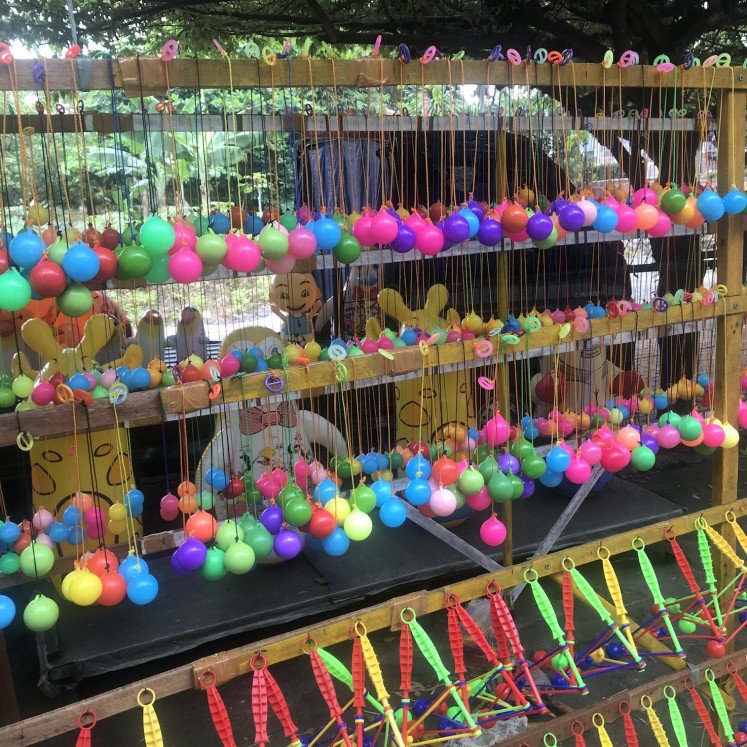February 13, 2023
JAKARTA – The clattering of lato-lato (clackers) has become unstoppable with the toy now a hit with millions of Indonesians, from President Joko “Jokowi” Widodo to schoolchildren nationwide, as it makes a comeback after nearly three decades
Aji entered the halls of his school following the Christmas and New Year’s holiday, keen to catch up with his friends in the South Jakarta private school he attends. The clack-clack-clack of the lato-lato perhaps reflected the 13-year-old’s upbeat outlook. Better known as clackers in the West, the sturdy balls connected by a string have caught on for Aji and his peers since November 2022. Little did Aji and his friends realize that the sound caused by crashing the balls below and above his wrist would be their undoing.
“The principal confiscated my lato-lato before the day was out. I did not see that coming,” he recalled with more than a bit of chagrin before taking a more defiant tone. “But it will not stop me from playing lato-lato, as I get much pleasure from playing and eventually mastering the toy.”
Gaining notoriety
Aji’s brush with the faculty is an example of one of several lato-lato crackdowns in schools carried out in Indonesian provinces such as Lampung, West Java and East Java, according to Kompas.com, since the beginning of 2023. The measures came after the toys were suspected of causing physical injuries, one time to an eight-year-old boy in West Kalimantan Province’s Kubu Raya Regency and another a five-year-old girl in the West Java town of Sukabumi, after the toys slipped out of their peers’ grasp. Lato-lato were also suspected of destroying windows and a TV LED screen in Cirebon, West Java, after the toy flew out of a five-year-old girl’s hand. It does not take much to imagine how devastating lato-lato can be in the hands of minors. A small, plastic ring held uneasily held between the forefinger and middle finger is all that one has to control the pair of weighted balls at the end of a couple of flimsy pieces of string.
The incidents occurred more than 50 years after the sale of lato-lato was banned in the United States and Canada due to safety concerns, which comes as no surprise to those who sell and handle them.

Ubiquitous: A row of lato-lato at a roadside stall in Pangkalan Jati, South Jakarta (JP/Tunggul Wirajuda) (JP/Tunggul Wirajuda)
“I’m not surprised lato-lato can be so damaging as they are made of titanium or reinforced polymer and other plastics,” said Rian, a street vendor selling lato-lato from a stall in Pangkalan Jati, South Jakarta, to The Jakarta Post on Jan. 31. “Lato-lato often make my arms black-and-blue from the impact. But apparently, it doesn’t detract from the toys’ appeal among children and young people, as well as the middle-aged and elderly.”
Tighter monitoring It did not take long to see what Rian meant. Lato-lato, for a price between Rp 3,000 (20 US cents) and Rp. 20,000, can be bought from various sources, ranging from roadside vendors like Rian and toy kiosks to online applications such as Shopee and Tokopedia.
For University of Indonesia child psychologist Vera Itabiliana, the toy’s bargain prices and ready availability highlighted the need for more monitoring.
“Like other toys, lato-lato should meet some criteria, namely that they should be of sturdy construction, high quality and easy to handle. Other factors include the child’s ability to play with the toy safely, as in keeping it at a safe distance from vulnerable parts of their body or others’,” she said. “Whether there is monitoring from adults is another factor, especially for children under 12. Lato-lato seem particularly risky for five-year-olds, so they need to be supervised more closely and shown how they should play lato-lato safely, where they can play, and if feasible, choose a lato-lato type or size that is suitable for them.”
Vera added that more studies into the adverse effects of lato-lato should be carried out before schools and other educational institutions impose bans or other preventive measures against the toy.
Unexpected advantages
While the spotlight on lato-lato might cast the toy in a negative light, the balls still have many supporters.
“As far as I’m concerned, lato-lato helped me hone my mental abilities. Playing it helped improve my concentration, accuracy and coordination,” said Almer, an eighth grader who caught the lato-lato bug this January. “Playing lato-lato also improves our communication, while our proficiency playing with them enables us to show our skills and engage with others in the real world. This is a far cry from the more impersonal world of online games and social media.” His classmate Aira agreed.
“Playing lato-lato helps me maintain focus despite the distractions, which in its case, is the racket as the balls clack against each other,” he said. “Lato-lato also brought my friends and I closer together and encouraged us to learn new skills. Doing so is more effective than playing online games collectively.”
Vera was more balanced, as she considered lato-lato’s pros and cons.
“Lato-lato supporters say it is beneficial in improving coordination, concentration and patience, among other things, while academics, officials and other detractors maintain that the noise creates a racket, disturbs peace and is generally disruptive. Neither side is wrong,” she asserted. “This creates the need to apply rules in playing lato-lato to maximize the benefits for all parties and minimize any damage or liabilities.”
Vera has yet to specify what the rules might be. But until she and others can lay down the ground rules, it is not too much to say that the racket from lato-lato balls crashing into one another is yet to end anytime soon.


